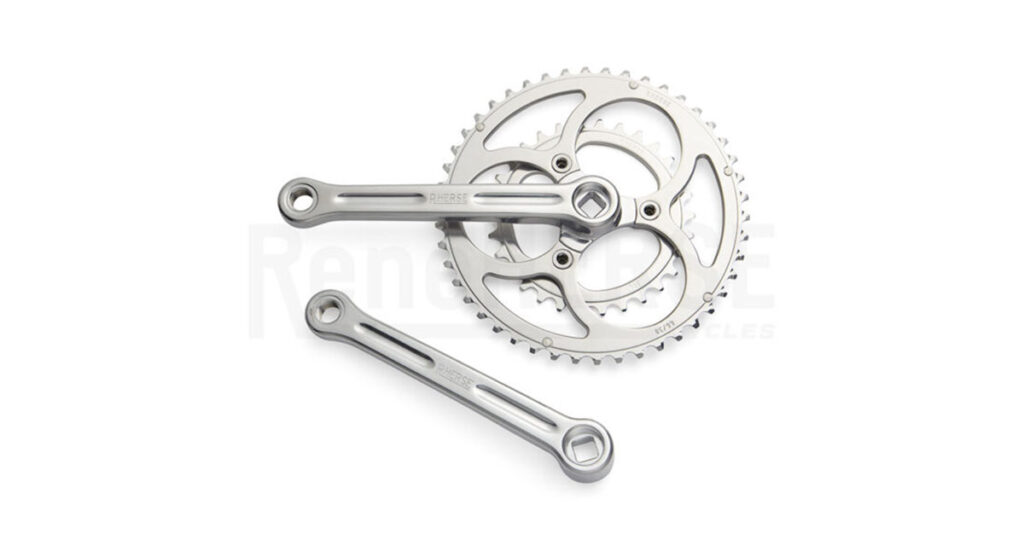How to Choose Your Chainrings

When we received another shipment of Rene Herse cranks recently, we built up and filled our pre-orders first. Some are shown above. All the cranks shown have different setups, except two. (Can you spot the two identical ones?)
There are a dozen different chainring combinations in the photo above, yet they represent only a small fraction of the possible chainring choices with our new cranks. We currently offer more than 100 different useful crank configurations to customize the crank to your power output and pedal style.
Compare that to most makers: Not counting track cranks, Shimano offers seven chainring combinations for their Dura-Ace cranks. Ultegra is available in four combinations, including a single triple. Campagnolo offers just three combinations for their Record cranks. None of the big makers offer 48-32, 44-28 or 46-36-24, combinations that are very useful for many riders.
Our Rene Herse cranks can be set up in even more chainring combinations, but our 100 combinations count only those that make sense and offer excellent shifting performance. Here is how to figure out an ideal chainring choice for you. (This post is excerpted from a more detailed article on gearing in the Summer 2012 issue of Bicycle Quarterly.)
One big rule is that the difference between adjacent chainrings ideally should not be larger than 16 teeth. You can use a larger difference – I once tested a bike with a 52-26 double – but your shifting will not be ideal. For example, a 48-32 (16 tooth difference) will shift fine with most front derailleurs, but a 48-30 (18 tooth difference) may require trimming of the front derailleur after each front shift. A large chainring difference also can result in the chain rubbing on the large chainring when you ride in the small chainring in the front and on one of the smaller cogs in the rear.
With this in mind, you can freely spec your favorite chainring combination. When I select my gearing, I think of three gears:
- Base gear: This is the gear I mostly use on flat roads when spinning along.
- High gear: This is the largest gear that I use when I am sprinting for a city limit sign with friends, or riding with a powerful tailwind.
- Low gear: This is the smallest gear I need on the roads I usually ride.
In addition to covering the range from low to high gear, a good gear selection will do the following:
- Put the base gear in the middle of the rear freewheel/cassette, so that I can adjust to changes in speed and terrain with a simple shift or two in the rear.
- Provide small enough steps between gears, so that I can continue pedaling seamlessly.
I don’t worry about duplicate gears, if they fall in the range where I ride frequently. In fact, some overlap is not just OK, it’s desirable.
The worst gearing I have ever ridden was that bike I mentioned above with the 52-26 chainrings. It had a 14-28 freewheel. On paper, this might look ideal: a huge gear range, and only one duplicate gear. On the road, it was far from perfect: In the big ring, the gearing was just a tad too large for slight uphills, while in the small ring, the gears were too small for the flats. As a result, I was shifting all the time, not only the front, but also almost all the way across the rear. This really broke my rhythm.
If I were riding that bike all the time, I’d simply add a third chainring (which is relatively easy with René Herse cranks).* Adding a 44-tooth ring would not have changed the gear range, and added five duplicate gears. On paper, that would be useless, but on the road, those would be the gears I would use 90% of the time! With the 44-tooth chainring, my base gear would be in the middle of the freewheel, and if the road tilts up or down a bit, I’d just need a simple shift on the rear to be in the right gear again. The 50-tooth chainring might be useful for super-fast rides, while the 26-tooth ring would get me up any hill.
Double or Triple?
The decision comes down to the gear range you need and which gears you ride most of the time. If your ‘base gear’ is close to your ‘high gear,’ then you can accommodate both on the same chainring. That means that you can use a double.
If your base gear is right in the middle between your ‘high’ and ‘low’ gears, then a double may put you between the two rings most of the time. Get a triple instead!
Alternatively, if you don’t like the wider tread (Q factor) of a triple, think about reducing your high gear. You don’t give up much – pedaling on steep downhills is slower than tucking in the aero tuck anyhow – and you may be able to use a double.
Choosing your gearing well will increase the enjoyment of your ride. Click here to see the chainring choices that are available for the Rene Herse cranks. For a more detail and examples of chainring choices, check out the Summer 2012 issue of Bicycle Quarterly.
* To convert a double René Herse crank to a triple, you need an extra chainring, longer chainring bolts, and (usually) a longer bottom bracket spindle.


